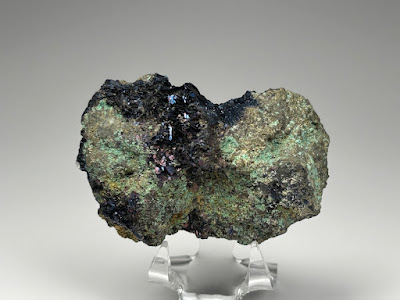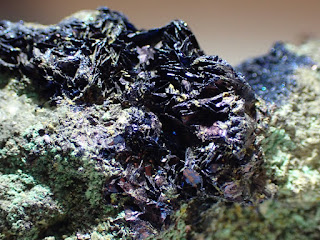小坂鉱山の銅藍 Covellite from Kosaka Mine
Size: 54 × 38 × 26 mm / Weight: 80 g
黒鉱型銅鉱床酸化帯に生じた銅藍(コベリン)の標本。黄鉄鉱や黄銅鉱を主体とする黄鉱中に晶洞ができて、その後天水の影響下で酸化され、その晶洞の「溜まり」に銅藍の結晶が密生したものとおもわれる。銅藍は六角形の薄板もしくは鱗片状で、径はせいぜい 2 ∼ 3 mm ほど。緑色の部分はなんらかの銅の2次鉱物。
A covellite specimen from an oxidized zone of a kuroko-type copper deposit. It is likely that there occurred a druse in a yellow-ore deposit mainly composed of pyrite and chalcopyrite, and that many covellite crystals grew after an oxidation process. The crystal is generally a thin hexagonal flake of 2 to 3 mm in size. There are some green copper-containing secondary minerals too.
今週開催中のホリミネラロジーのセールにて購入。1970年から80年代に同社が収集した研究資料標本の放出ということだったが、堀秀道の手書きとおぼしきラベルの風合いからして確かにそれくらいの時代を感じる。そして標本自体はもっと古いものと想像する。小坂鉱山の鉱床は大別すると元山(もとやま)地区と内の岱(うちのたい)地区とに分けられるが、後者は戦後発見された潜頭鉱床(地表に露頭をもたない鉱床)で大規模な酸化帯を伴わず、この標本のような銅の2次鉱物はあまりみられなかったと思われる。いっぽう元山鉱床はもともと土鉱(黒鉱が酸化して土状になった鉱石)から銀を採取したところで、かなりの2次鉱物がみられた。小坂の銅藍は和田維四郎「日本鉱物誌」(1904年/明治37年)には記載がなく、その改訂版(1916年/大正5年)ではじめて紹介されているので、1910年前後に発見もしくは広く認識されたのだろう。ちょうど元山が大々的に露天掘りされていた時代だ。元山の黒鉱は1920年(大正9年)頃にはすでに掘り尽くされた(「七十年の回顧」同和鉱業、1955年)ようなので、この標本も大正年間頃のものの可能性が高い。
日本には数多くの銅山が存在するがこのように肉眼でじゅうぶん観察できるくらいの銅藍の結晶はほとんど産出しない。近年では山梨県増富鉱山のものが出回っているくらいだ。世界的に見ても銅藍の産地は限られており、結晶サイズが 1 cm を超えるものはかなり稀である(たとえば堀秀道「楽しい鉱物図鑑」草思社、1992年)。最大で径 15 mm、厚さ 1.5 mm の結晶が出た(日本鉱物誌・改訂版)という小坂・元山の銅藍は、実は世界に誇っていいレベルにあるとおもう。ただしなにぶん100年も前に採集された代物で現存する標本が少なく、今となってはちょっと影の薄い存在である。
I found it in a special exhibition of Hori Mineralogy, where old stocks in 1970s and 80s were on sale. The label written by Hori Hidemichi indicated it was surely old. Actually, I suppose this piece of copper ore is much older. In the Kosaka Mine, there were two mining districts, Motoyama and Uchinotai. The latter was a blind deposit found after the Pacific War, and there were few secondary minerals. On the other hand, Motoyama was an older mining district where near-surface earthy ores altered from the kuroko were mined to obtain silver in the mid 19th century. Motoyama's covellite first appeared in the literature in 1916 (the 2nd edition of Wada's Minerals of Japan). As the Motoyama open pit was almost exhausted in 1920, this specimen would be also collected in the beginning of the 20th century.
Despite the fact that Japan has a large number of copper mines, covellite crystals large enough to be seen with the naked eye are generally uncommon. In recent Japanese mineral markets, the locality is essentially restricted to the Masutomi Mine, Yamanashi. Good covellite crystals larger than 1 cm are quite rare even in the world. As the crystals to 15 mm in size and 1.5 mm in thickness have been known in Kosaka, I think this site is one of the world-class localities of covellite. However, it is not very renowned in today's mineral markets because we seldom have a chance to see such historic 100-year-old specimens.
補足
以前紹介した花岡鉱山産の銅藍の標本。おなじ北鹿地方の黒鉱鉱山だが、こちらは結晶サイズが 1 桁小さい。
昭和10年(1935年)に出版された「日本鉱物資料 続 第1巻」(伊藤貞一 編)の中で、片山信夫が小坂の銅藍について記している。それによると「銅藍の結晶の記載ははなはだ稀である。先年、秋田県小坂鉱山にその良晶を産出した」。この「先年」がどのくらい昔のことを指すのか不明瞭だが、おそらく20年くらい前のできごとを回顧していて、執筆当時ではすでに絶産していたのだろう。




